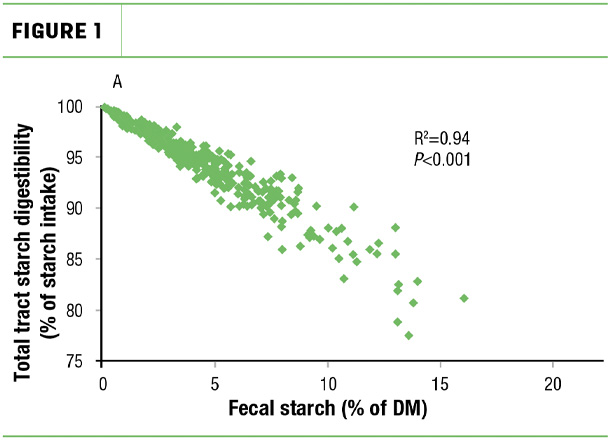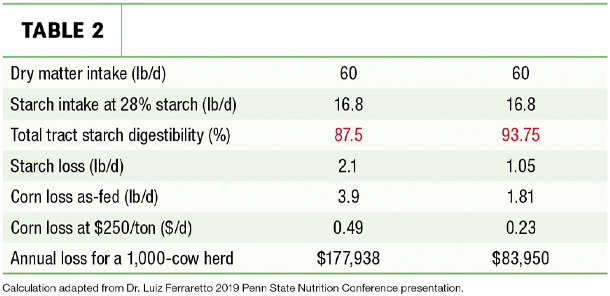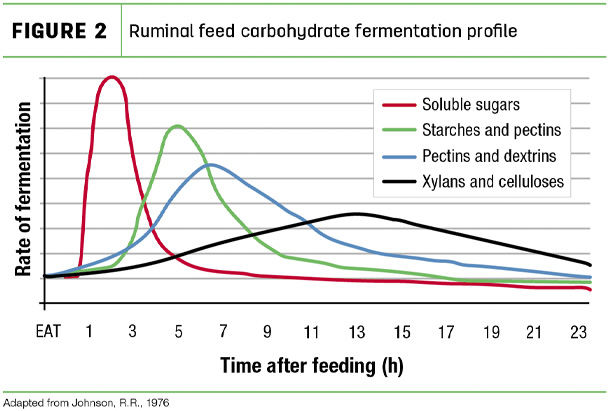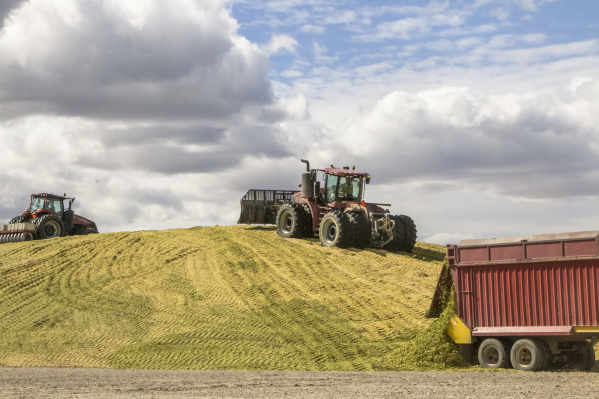Total tract digestibility, fecal starch and economics
Once consumed by the cow, starch will be digested in the rumen, small intestine and hindgut. Total tract starch digestibility (TTSD) estimates starch digested in both rumen and post-ruminal tracts. Optimizing ruminal starch digestion helps maximize volatile fatty acids (VFAs), nitrogen utilization and microbial protein in the rumen to enhance milk and component production. Some starch will escape ruminal and post-ruminal degradation and end up in the manure, which can be quantified through fecal starch analyses. Research shows strong correlations between total tract digestibility and fecal starch. A 5% fecal starch is roughly correlated with 95% total tract digestibility, and 7% fecal starch is roughly correlated with 90% total tract digestibility.
Increased fecal starch percentage indicates reduced total tract starch utilization and lost production. For instance, every 1% increase in fecal starch over 3% may reduce milk yield by 0.7 pound per cow. At $16.50 per hundredweight (cwt), this is a milk income loss of 11 cents per cow per day per unit of fecal starch over 3%. While 3% may not be achievable in all settings due to variations in growing season, harvest conditions and feeding management, keeping a practical goal of 3% to 5% helps optimize milk production and reduce waste.
Based on over 1,000 fecal samples submitted to Dairyland Laboratories for the 2019 crop year, about 50% of samples were greater than 3%, and about 30% of the samples showed greater than 5% fecal starch (Figure 1).

Although the data do not represent entire farm demographics, there are certainly opportunities for some dairy farms to reduce fecal starch loss. University of Wisconsin interpretation guidelines for fecal starch analyses are in Table 1.

The high cost of undigested starch
How much does undigested starch cost? Let’s use 87.5% total tract starch digestibility as an example to calculate the costs of undigested starch. For a typical cow with DMI at 60 pounds per day and dietary starch at 28% dry matter, the daily intake of starch is 60 x 28% = 16.8 pounds per day.
- Corn grain has 70% starch; if a cow has 87.5% total tract starch digestibility, then for 1 pound of dry matter corn, the digested starch is: 1 pound dry matter corn x 70% starch x 87.5% digestibility = 0.61 pound of digestible starch.
- Also, daily loss of starch is 16.8 pounds per day x (100 - 87.5)% = 2.1 pounds per day starch.
We can then calculate that corn loss per day is: 2.1 pounds per day divided by 0.61 = 3.44 pounds of dry matter corn.
- If corn has a dry matter of 88%, then 3.44 pounds of dry matter corn is equivalent to: 3.44 divided by 88% = 3.9 pounds of as-fed corn.
- If corn grain price is $250 per ton (or 12.5 cents per pound), then 3.9 pounds of corn is worth 49 cents loss per cow per day.
- For a 1,000-cow herd, that is $177,938 per year.
Similarly, we can calculate that for 93.75% total tract starch digestibility, the costs of undigested starch is around 23 cents per cow per day, or $83,950 per year for a 1,000-cow herd. The calculation is summarized in Table 2.

How to cope with undigested starch
A key to a successful nutrition program is to have high-quality feed ingredients available, such as highly digestible corn silage. Among other factors, one of the most important starch digestibility indicators is corn silage kernel processing score, which estimates percent of starch passing through 4.75-millimeter sieve. Corn silage with over 70% of the starch passing through the sieve is considered as optimally processed.
Excellent kernel processing is critical to maximize the potential of starch digestion. On the other hand, feeding overprocessed corn or corn silage, or too much “hot” high-moisture corn, can easily depress milkfat and result in acidosis. If a farm is facing the issue of undigested starch, consider using alternative carbohydrate sources such as sugar (molasses-based products) or soluble fiber (soyhulls) to replace some starch. Sugar and soluble fiber are highly digestible and are more rumen-friendly compared with starch. Sugars are digested and used by the rumen microbes very rapidly and can help to provide the energy needed at the right time in relation to the fermentation of other carbohydrates in the ration, as shown in Figure 2.

Sugars help the rumen microbes capture and use nitrogen sources in the diet, especially rapidly digestible nitrogen sources such as the soluble protein. Recent research recommended feeding rations containing around 7% sugar for maximal milk component yields. Fiber digestion, microbial protein synthesis and energy absorption from the rumen can increase with additional dietary sugars. ![]()
PHOTO: Lynn Jaynes.
-
Kai Yuan
- Dairy Senior Scientist
- Technical Adviser
- Quality Liquid Feeds
- Email Kai Yuan







